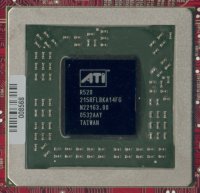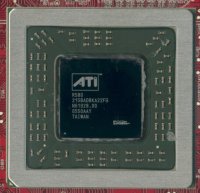The R580 Graphics Chip
Obviously, with 3 times more shader pipelines than R520, R580 is a little more significant a refresh than previous ATI parts, which has ramifications on the chip. Here we'll take a look at the details of it and a quick summary of the technologies and 3D capabilities it houses.
R580 packs in around 384M transistors, about 20% more than R520's 320M, and as it uses the same TSMC's 90nm Nexsys process technology as the rest of the R5xx range the the die size has grown accordingly.
We can see that the production chip here is marked as "A22", indicating that this is the second layer change as well as a silicon revision. As far as we are aware, R580 had actually taped out by June '05, however when it came back, it was afflicted with the same issues that caused the delay to R520, which we believe to be a 3rd party library issue somewhere in the memory subsystem. Given the timescales with which they were working ATI had the option of stopping work on R520 and attempting to move to R580 ASAP, however seeing as it still had the same issues as R520 (and potentially other issues that are common when first silicon comes back) they persevered with R520 as they had already spent considerable effort chasing down its issues. Once the issue was resolved with R520 they could then proceed with resolving them on subsequent parts, first RV530 (which also features the same memory technology) and then R580. This is why there is a relatively short time between R520's release and availability of R580 based products.
With the use of the 90nm process R580 can make use of Dynamic Voltage Control. Dynamic Voltage Control can allow software control over the voltage supplied to the chip in order to scale down the performance under scenarios it is not needed, such as 2D operation, and then scale them back up when higher workload demands are placed on it, such as rendering complex 3D scenes.
R580 utilises the same architecture as R520, and brings all the same functionality as R520, with the addition of Fetch4 capabilities. Here is an overview of the features and technologies of R580:
- Ultra Threaded Shader Engine
- Support of DirectX9 Programmable Vertex and Pixel Shaders
- VS3.0 Vertex Shader functionality
- 1024 Instructions (Unlimited with flow control)
- Single Cycle Trigonometric Operations (SIN & COS)
- PS3.0 Pixel Shaders
- Ultra Thread Pixel Shader Engine
- Fast Dynamic Branching
- Single Precision 128-bit Floating Point (FP32) Processing
- 16 textures per rendering pass
- 32 temporary and constant registers per pixel
- Facing register for two-sided lighting
- Multiple render target support
- Shadow volume rendering acceleration
- 128-bit, 64-bit & 32-bit per pixel floating point colour formats
- Advanced Image Quality Features
- HDR Blending on FP16, Int10 and Custom Formats
- All Blending modes work with all Anti-Aliasing Modes
- 3Dc+ Normal Map Compression
- High quality 4:1 Normal Map Compression
- Two Channel & Single Channel format support
- 2x/4x/6x Multi-Sampling full scene Anti-Aliasing modes, adaptive algorithm with programmable sample patterns and colour buffer compression
- Adaptive Anti-Aliasing for Transparent Surfaces
- Temporal Anti-Aliasing
- Lossless Color Compression (up to 6:1) at all resolutions, including widescreen HDTV resolutions
- High Quality, Angle Invariant, Anisotropic Filter Mode
- 2x/4x/8x/16x Anisotropic Filtering modes
- 4Kx4X texture Support
- Fetch4 Texture Sampling
- HDR Blending on FP16, Int10 and Custom Formats
- Ring Bus Memory Controller
- Internal Ring Bus Architecture
- Programmable Arbitration Logic
- Fully Associative Caches
- 3-level, Floating Point, Hierarchical Z-Buffer with early Z test
- Lossless Z-Buffer compression (up to 48:1)
- Fast Z-Buffer Clear
- Z Cache Optimisations for shadow rendering
- Optimized for performance at high display resolutions, including widescreen HDTV resolutions
- AVIVO
- Dual 10-bit Display Pipelines
- Dual Integrated Dual Link TMDS Transmitters, Dual 400MHz RAMDACS, Xilleon Derived TV Output.
- Hardware Accelerated H.264 Decode
For a more complete understanding of the R5xx architecture we'd recommend reading our "ATI R520: Radeon X1800" article. We'll be looking at X1900 Crossfire, ATI's dual graphics rendering process, in this article and the details of the rendering methods can be found in our "ATI Radeon X1800 XT Crossfire" article. Finally, R580 also features ATI's Avivo video functionality, more of which can be read about here.


